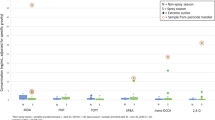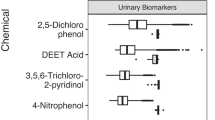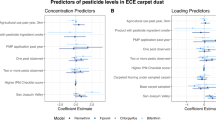Abstract
The take-home pathway is a significant source of organophosphate pesticide exposure for young children (3–5 years old) living with an adult farmworker. This avoidable exposure pathway is an important target for intervention. We selected 24 agricultural communities in the Yakima Valley of Washington State and randomly assigned them to receive an educational intervention (n = 12) to reduce children’s pesticide exposure or usual care (n = 12). We assessed exposure to pesticides in nearly 200 adults and children during the pre and post-intervention periods by measuring metabolites in urine. We compared pre- and post-intervention exposures by expressing the child’s pesticide metabolite concentration as a fraction of the adult’s concentration living in the same household, because the amount of pesticides applied during the collection periods varied. Exposures in our community were consistently higher, sometimes above the 95th percentile of the exposures reported by the National Health and Nutrition Examination Survey (NHANES). While intervention and control communities demonstrated a reduction in the ratio of child to adult exposure, this reduction was more pronounced in intervention communities (2.7-fold, p < 0.001 compared to 1.7-fold, p = 0.052 for intervention and control, respectively). By examining the child/adult biomarker ratio, we demonstrated that our community-based intervention was effective in reducing pesticide exposure to children in agricultural communities.
This is a preview of subscription content, access via your institution
Access options
Subscribe to this journal
Receive 6 print issues and online access
$259.00 per year
only $43.17 per issue
Buy this article
- Purchase on Springer Link
- Instant access to full article PDF
Prices may be subject to local taxes which are calculated during checkout



Similar content being viewed by others
References
WSDA. Agriculture: A Cornerstone of Washington’s Economy. 2014; Available from: http://agr.wa.gov/AgInWA/.
Bouchard MF, Chevrier J, Harley KG, Kogut K, Vedar M, Calderon N, et al. Prenatal exposure to organophosphate pesticides and IQ in 7-year-old children. Environ Health Perspect. 2011;119:1189–95.
Engel SM, Wetmur J, Chen J, Zhu C, Barr DB, Canfield RL, et al. Prenatal exposure to organophosphates, paraoxonase 1, and cognitive development in childhood. Environ Health Perspect. 2011;119:1182–8.
Rauh V, Arunajadai S, Horton M, Perera F, Hoepner L, Barr DB, et al. Seven-year neurodevelopmental scores and prenatal exposure to chlorpyrifos, a common agricultural pesticide. Environ Health Perspect. 2011;119:1196–201.
Coronado GD, Vigoren EM, Thompson B, Griffith WC, Faustman EM. Organophosphate pesticide exposure and work in pome fruit: evidence for the take-home pesticide pathway. Environ Health Perspect. 2006;114:999–1006.
Thompson B, Coronado GD, Grossman JE, Puschel K, Solomon CC, Islas I, et al. Pesticide take-home pathway among children of agricultural workers: study design, methods, and baseline findings. J Occup Environ Med. 2003;45:42–53.
Thompson B, Griffith WC, Barr DB, Coronado GD, Vigoren EM, Faustman EM. Variability in the take-home pathway: farmworkers and non-farmworkers and their children. J Expo Sci Environ Epidemiol. 2014;24:522–31.
Deziel NC, Friesen MC, Hoppin JA, Hines CJ, Thomas K, Freeman LE. A review of nonoccupational pathways for pesticide exposure in women living in agricultural areas. Environ Health Perspect. 2015;123:515–24.
Smith MN, Workman T, McDonald KM, Vredevoogd MA, Vigoren EM, Griffith WC, et al. Seasonal and occupational trends of five organophosphate pesticides in house dust. J Expo Sci Environ Epidemiol. 2016;27:372–8.
Holme F, Thompson B, Holte S, Vigoren EM, Espinoza N, Ulrich A, et al. The role of diet in children’s exposure to organophosphate pesticides. Environ Res. 2016;147:133–40.
Thompson B, Coronado GD, Grossman JE, MD KP, Solomon CC, Islas I, et al. Pesticide Take-Home Pathway among Children of Agricultural Workers: Study Design, Methods, and Baseline Findings. J Occup Environ Med. 2003;45:42–53.
Strong LL, Thompson B, Koepsell TD, Meischke H, Coronado GD. Reducing the take-home pathway of pesticide exposure: behavioral outcomes from the Para Ninos Saludables study. J Occup Environ Med. 2009;51:922–33.
Thompson B, Coronado GD, Vigoren EM, Griffith WC, Fenske RA, Kissel JC, et al. Para ninos saludables: a community intervention trial to reduce organophosphate pesticide exposure in children of farmworkers. Environ Health Perspect. 2008;116:687–94.
Griffith W, Curl CL, Fenske RA, Lu CA, Vigoren EM, Faustman EM. Organophosphate pesticide metabolite levels in pre-school children in an agricultural community: within- and between-child variability in a longitudinal study. Environ Res. 2011;111:751–6.
Israel BA, Parker EA, Rowe Z, Salvatore A, Minkler M, Lopez J, et al. Community-based participatory research: lessons learned from the Centers for Children’s Environmental Health and Disease Prevention Research. Environ Health Perspect. 2005;113:1463–71.
USCB. Yakima County, Washington. United States Census Bureau (2011).
Coronado GD, Thompson B, Strong L, Griffith WC, Islas I. Agricultural task and exposure to organophosphate pesticides among farmworkers. Environ Health Perspect. 2004;112:142.
Curl CL, Fenske RA, Kissel JC, Shirai JH, Moate TF, Griffith W, et al. Evaluation of take-home organophosphorus pesticide exposure among agricultural workers and their children. Environ Health Perspect. 2002;110:A787–92.
Medlock JM, Leach SA. Effect of climate change on vector-borne disease risk in the UK. Lancet Infect Dis. 2015;15:721–30.
Lunn DJ, Thomas A, Best N, Spiegelhalter D. WinBUGS-a Bayesian modelling framework: concepts, structure, and extensibility. Stat Comput. 2000;10:325–37.
Lunn D, C Jackson, N Best, A Thomas & D Spiegelhalter. The BUGS book: a practical introduction to Bayesian analysis. (CRC press, Boca Raton 2012).
Coronado GD, Vigoren EM, Griffith WC, Faustman EM, Thompson B. Organophosphate pesticide exposure among pome and non-pome farmworkers: a subgroup analysis of a community randomized trial. J Occup Environ Med. 2009;51:500–09.
Zhang X, Driver JH, Li Y, Ross JH, Krieger RI. Dialkylphosphates (DAPs) in fruits and vegetables may confound biomonitoring in organophosphorus insecticide exposure and risk assessment. J Agric Food Chem. 2008;56:10638–45.
Arcury TA, Marín A, Snively BM, Hernández-Pelletier M, Quandt SA. Reducing farmworker residential pesticide exposure: evaluation of a lay health advisor intervention. Health Promot Pract. 2009;10:447–55.
Forster-Cox SC, Mangadu T, Jacquez B, Corona A. The effectiveness of the promotora (community health worker) model of intervention for improving pesticide safety in US/Mexico border homes. Calif J Health Promot. 2007;5:62–75.
Quandt SA, Arcury TA, Austin CK, Cabrera LF. Latino Immigrants: preventing occupational exposure to pesticides: using participatory research with latino farmworkers to develop an intervention. J Immigr Health. 2001;3:85–96.
Quandt SA, Grzywacz JG, Talton JW, Trejo G, Tapia J, D’Agostino RB, et al. Evaluating the effectiveness of a lay health promoter-led, community-based participatory pesticide safety intervention with farmworker families. Health Promot Pract. 2013;14:425–32.
Bradman A, Salvatore AL, Boeniger M, Castorina R, Snyder J, Barr DB, et al. Community-based intervention to reduce pesticide exposure to farmworkers and potential take-home exposure to their families. J Expo Sci Environ Epidemiol. 2009;19:79–89.
Salvatore AL, Castorina R, Camacho J, Morga N, Lopez J, Nishioka M, et al. Home-based community health worker intervention to reduce pesticide exposures to farmworkers’ children: A randomized-controlled trial. J Expo Sci Environ Epidemiol. 2015;25:608–15.
Bello GA, Arora M, Austin C, Horton MK, Wright RO, Gennings C. Extending the Distributed Lag Model framework to handle chemical mixtures. Environ Res. 2017;156:253–64.
Bergen S, Sheppard L, Kaufman JD, Szpiro AA. Multipollutant measurement error in air pollution epidemiology studies arising from predicting exposures with penalized regression splines. J R Stat Soc C. 2016;65:731–53.
Acknowledgements
This publication was made possible by grants PO1 ES009601 from NIEHS, and EPA RD-83170901, RD826886, RD83451401, RD-83273301.
Author information
Authors and Affiliations
Corresponding author
Ethics declarations
Conflict of interest
The authors declare that they have no conflict of interest.
Electronic supplementary material
Rights and permissions
About this article
Cite this article
Griffith, W.C., Vigoren, E.M., Smith, M.N. et al. Application of improved approach to evaluate a community intervention to reduce exposure of young children living in farmworker households to organophosphate pesticides. J Expo Sci Environ Epidemiol 29, 358–365 (2019). https://doi.org/10.1038/s41370-018-0028-y
Received:
Revised:
Accepted:
Published:
Issue Date:
DOI: https://doi.org/10.1038/s41370-018-0028-y
This article is cited by
-
Cultural appropriateness in randomized controlled trials (RCTs) aimed at reducing pesticide exposure among farmers and farmworkers: a systematic review
International Archives of Occupational and Environmental Health (2023)
-
Seeing the workers for the trees: exalted and devalued manual labour in the Pacific Northwest craft cider industry
Agriculture and Human Values (2022)



